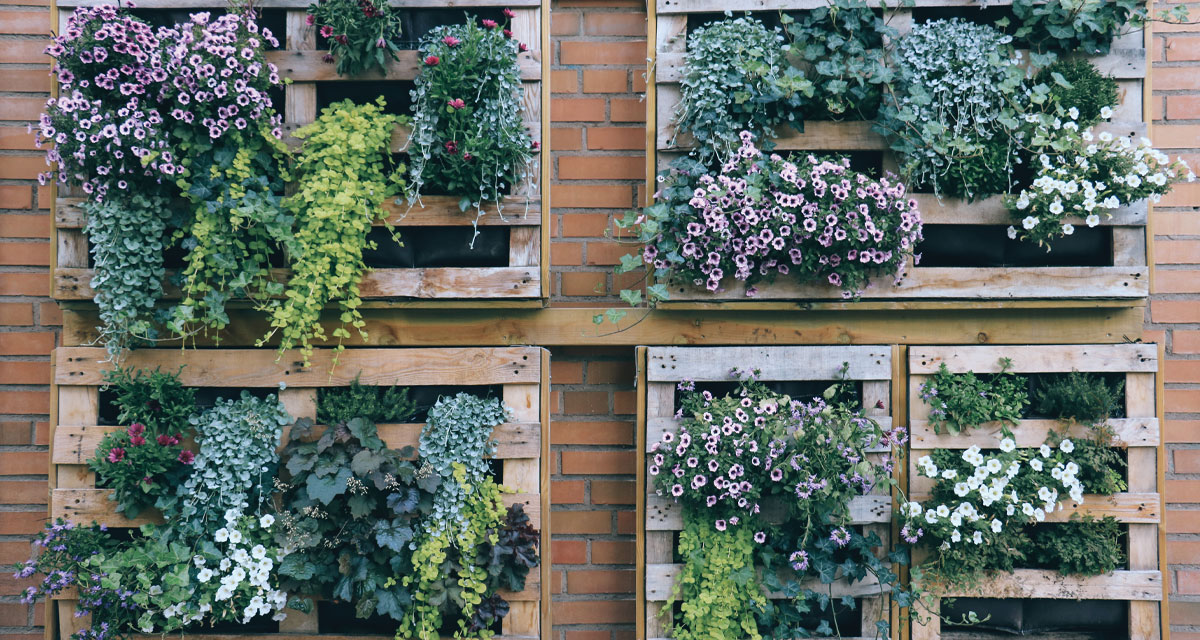Green thumb people think differently. Despite dwelling in urban circumstances or in small spaces, you can still allow your creative mindset to dream of vertical or hanging structures. Gardening may be a science, but it’s an art form, too. Everyone can grow beautiful flowers, vegetables, and fruits with love, a trowel, a watering can, saucers, and ingenuity.
The Requirements
Growing well-nourished, healthy plants in a suitable environment requires three basic components—a minimum of six hours of sunlight, well-drained soil, and water.
- Clean your containers with each new planting, dusting the bottom with baking soda before adding soil.
- To ensure the plant has the best possible environment, always start with fresh, all-purpose soil, or consider saving money and making your own.
- Soil depth is critical. When planting, consider a pot at least six inches deep to accommodate roots under one foot in height. Deeper roots need one foot of soil.
- Assess leaves if yellowing or drooping; pull up on the plant’s trunk to determine if a transplant is needed.
- Five-gallon buckets are a popular, inexpensive container. Drill holes at the bottom to ensure water can escape.
- Even in fall gardens, water is essential for optimal growth. Use the finger test to determine whether your plants need hydration. Soil remnants that remain on your finger indicate moisture; lack of moisture requires watering. Soak each container until water arrives in the saucer.
The Best Pots
Containers come in a variety of colors, sizes, and materials. When it comes to choosing the best pot, consider the potential growth of each plant. There are also options offering moisture control. The porous walls of terracotta pots allow water and air to move quickly; although they do well with drought-tolerant plants, clay does cause plants to dry out faster and require more frequent watering.
Other types of containers:
- Stone is well-suited for permanent fixtures. Its frost proof qualities and weight permit its use in a year-round environment. It does require continual watering.
- Glazed ceramic pots are decorative and expensive, and susceptible to breaking.
- Metal pots are not suited for the outdoors, due to rusting and the fact that they absorb heat.
- Wooden containers, typically made from cedar, last long and are pest resistant. They are Ideal as planters or window boxes.
- Treated wood, due to its chemicals, is harmful to plants and requires a plastic lining.
- Polyresin is a lightweight, durable, and inexpensive material, resembling stone or weathered concrete; however, it is susceptible to wind and likely to tip over.
Vertical Gardening
For centuries, gardeners implemented trellis-based support structures to give vines and other climbing plants a lift. In rural locations, too, you can transform a wall into an artistic design of greenery and color. By condensing the growing space, the structure is easy to maintain and harvest. Pallets, as an accessible and cost-effective item, create the ideal platform. With plywood, landscape cloth, and a staple gun, the transformation offers rows of viable growing boxes. The pallet(s) will later need an anchor for extra security and support. Just imagine a lush blanket of greenery, such as vegetable plants or succulents. It’s one of many options.
- Gutters and PVC pipe provide a viable window box. Drilling holes at the bottom ensures plants don’t become waterlogged.
- In large barrel-like pots or buckets, use bamboo sticks, cages, or twine to contain height. It’s vital to sink posts into the base, creating strong support to withstand the weight.
- Whether purchased or homemade, tower gardens provide large pockets to offer many plants in a finite space. With a pump and hose, the tower could support aquaponics.
- Obelisks are a four-sided, pyramid-shaped growing system constructed from wood, twigs, grapevines, plastic, or metal.
- Walkway arbors or arches with latticework can support climbing plants.
- Teepees made from sturdy twigs, tied with twine, can lead to a permanent structure designed from heavy-duty garden stakes. Create a vegetable garden while giving children a means to play.
Creating a green environment for living plants is an exciting endeavor. With the season of cold crops underway, start small, take notes, and expand your containers in the spring!
*Lisa is an N.C. State Extension Master Gardener Volunteer and state-certified beekeeper.



















